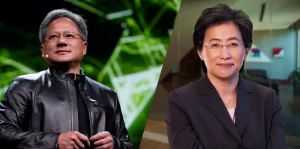Introduction:
In a rapidly evolving digital landscape, the demand for high-performance computing solutions has never been greater. Nvidia unveils the R-series/R100 AI chip, a leap in innovation. Mass production begins in Q4 2025. System and rack solutions follow in H1 2026. The R100 promises unparalleled computational prowess. It’s poised to revolutionize data centers globally. Nvidia continues to lead in AI and GPU technology.
Follow us on LinkedIn for everything around Semiconductors & AI
Family of Nvidia Chips
Generations (Code Name):
Turing (RTX 20 series): Released in 2018, this generation introduced real-time ray tracing capabilities for consumer GPUs.
Ampere (RTX 30 series): Launched in 2020, Ampere offered significant performance improvements over Turing and further refined ray tracing technology.
Blackwell (B100): Released in (presumably) 2024, Blackwell is the current generation for high-performance computing and AI, focusing on raw performance and efficiency. It’s the first Nvidia GPU to utilize a chiplet design.
Rubin (R100): Expected in late 2025, Rubin is the next step in Nvidia’s AI accelerator line. It leverages the advancements of Blackwell (potentially being its successor) and takes them further with a smaller 3nm manufacturing process and potentially CoWoS-L packaging for even denser integration.
Focus by Generation:
Turing: Focused on introducing real-time ray tracing for gaming.
Ampere: Continued focus on ray tracing alongside significant performance improvements for gaming and professional workloads.
Blackwell: High-performance computing and AI, emphasizing raw power and efficiency with a chiplet design.
Rubin: Expected to prioritize AI applications even further, potentially with even greater performance gains and improved power efficiency due to the 3nm process.
Key Evolutionary Points:
- Introduction of real-time ray tracing (Turing)
- Advancement in ray tracing and overall performance (Ampere)
- Chiplet design for increased efficiency and potential performance gains (Blackwell)
- Move to a smaller 3nm process and potentially denser packaging for further performance and efficiency improvements (Rubin)
Powering the Future: Key Technological Advancements
Cutting-Edge Semiconductor Manufacturing
The R100 represents a significant leap forward in semiconductor manufacturing, leveraging TSMC’s cutting-edge N3 node technology. This node offers enhanced performance, reduced power consumption, and increased transistor density compared to its predecessors, setting the stage for unparalleled computational capabilities.
Read More: Apple M4 vs M2: Check Out the Performance Gains of the New Chip – techovedas
CoWoS-L Packaging
Building upon the success of its predecessor, the R100 adopts CoWoS-L ( Chip-on-Wafer-on-Substrate – Low.) packaging, ensuring efficient thermal management and signal integrity while maintaining a compact form factor. This advanced packaging technology enables seamless integration with existing infrastructure and facilitates rapid deployment in data center environments.
Denser Integration: By stacking chips on the interposer, CoWoS-L allows for a more compact design compared to traditional packaging methods. This can be crucial for fitting more powerful components into a smaller space.
Shorter Interconnects: The close proximity of chips on the interposer reduces the distance electrical signals need to travel, leading to faster communication and potentially improved performance.
Increased Bandwidth: CoWoS-L can accommodate high-bandwidth memory like HBM directly on the interposer, enabling faster data transfer between the processor and memory.
Overall, CoWoS-L is a powerful packaging technique that allows for creating high-performance, compact computing modules. It’s particularly beneficial for applications like AI accelerators that demand both raw processing power and efficient data flow.
Read More: $20 Million Initiative: How Nvidia & MITRE Supercomputer Will Boost AI for US Govt. – techovedas
Enhanced Reticle Design
With a reticle design boasting approximately 4x the capacity of its predecessor, the R100 maximizes silicon real estate, allowing for the integration of more compute units and accelerators. This optimized design ensures optimal performance while minimizing manufacturing complexities and costs.
Read More: Top 5 VLSI Books for Beginners in VLSI Technology 2024 – techovedas
HBM4 Integration
Equipped with eight HBM4 units, the R100 delivers unprecedented memory bandwidth and capacity, enabling lightning-fast data access and manipulation for AI workloads. This high-bandwidth memory architecture is instrumental in accelerating AI training and inference tasks, empowering data centers to tackle complex computational challenges with ease.
Grace CPU: Next-Generation Processing Power
The R100 introduces the GR200 Grace CPU. It harnesses TSMC’s N3 process technology.
This ensures unparalleled processing power and efficiency. The CPU architecture is tailored for modern AI workloads. It seamlessly integrates compute and AI acceleration capabilities.
Read More:U.S Revokes Licenses to Export Goods, Including Chips to Huawei After AI Laptop Launch – techovedas
Addressing Industry Challenges: A Focus on Energy Efficiency
Nvidia recognizes the growing significance of energy consumption in AI server deployments, particularly in the context of CSP and hyperscale data centers. As such, the R-series chips and system solutions are meticulously designed to prioritize energy efficiency alongside raw computational power.
By leveraging advanced semiconductor technologies, innovative packaging solutions, and optimized architectural designs, Nvidia aims to mitigate the environmental impact of data center operations while empowering customers to achieve their computational goals more sustainably.
Read More : US Will Make at Least 25% Advanced Chips in 2032 Compared to 2% by China – techovedas
Conclusion: Pioneering the Future of AI Computing
The introduction of the R100 AI chip marks a pivotal moment in the evolution of data center technology. With its unrivaled performance, efficiency, and scalability, the R100 is poised to redefine the boundaries of AI computing, empowering organizations to unlock new possibilities and drive innovation at scale.
As Nvidia continues to push the envelope of technological innovation, the R100 stands as a testament to the company’s unwavering commitment to advancing the field of AI and revolutionizing the way we approach computational challenges in the digital age.




